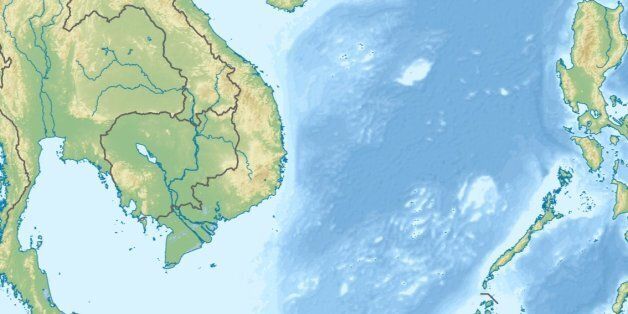
Dokdo/Takeshima. Senkaku/Diaoyu. Xisha/Hoang Sa (aka the Paracels). The Spratlys. If your reaction is "Huh?" it's because these are clumps of islets and clusters of rocks -- most with no permanent inhabitants to speak of -- that dot the Sea of Japan and the East and South China seas. While obscure and small, the rows and saber rattling they spark regularly offer clues about East Asia's future. And that gives them an outsize significance.
South Korea controls the Dokdo, but Japan rejects Seoul's claim to ownership to what it calls Takeshima. In 2006, South Korea sent its navy to the islands to stop a Japanese survey mission. Last month -- the 67th anniversary of the end of World War II in the Far East--South Korean president Lee Myung-bak angered Japan by flying to the territories, stirring things up further a few days later by opining that Japan's emperor should apologize for Japan's past misdeeds (which included the colonization of the Korean peninsula from 1910-45) if he wished visit South Korea.
The animosity surrounding the Senkaku/Diaoyu islands is no less intense. Here Japan -- or at this point a private Japanese owner -- has possession of what it calls Senkaku islands and China the Diaoyutai. This month, the dispute heated up following reports that Japan's government had decided to purchase the islands. Beijing blasted this attempt to establish official control and vowed to defend its sovereign rights. Tension between both countries was already running high because of two other incidents that occurred in August. A large group of Japanese nationalists sailed to islands, and some left their vessels and swam to one of them and hoisted Japan's flag. In various Chinese cities, irate crowds torched Japanese flags and vandalized Japanese vehicles and restaurants. Later, a Chinese group sailed to the islands from Hong Kong, and when some of its members attempted a landing on one of them, Japan's coast guard detained and deported them.
As for the Paracels (Xisha in Chinese, Hoang Sa in Vietnamese), China acquired the entire group following a 1974 war with South Vietnam, which had exercised partial control, and has since placed troops on the archipelago. But verbal volleys and gunboat diplomacy between Beijing and Hanoi persist.
The Spratlys are claimed by China, but also by Vietnam, the Philippines, Taiwan, Malaysia, and Brunei in what are complex assertions of rightful possession over all or parts of the archipelago, backed in instances by possession. China has taken a tough line. The "Nine-Dash Line" on its maps encloses virtually all of the South China Sea and the entire Spratly group, some 50 islands, plus the Paracels. The Chinese navy patrols the area and has even fired on Vietnamese vessels. Beijing spurns proposals for multilateral negotiations and tells the United States to butt out.
The larger significance of the squabbling over these maritime territories is that it reveals several trends -- some present, some emerging -- shaping East Asia's strategic setting.
The Takeshima/Dokdo and Senkaku/ Diaoyu tiffs show that the wounds from Japan's 20th century imperial conquests and occupations still remain raw. Tokyo's peaceful post-war foreign policy has failed to win hearts and minds in the neighborhood.
The disputes over the Senkaku/Diaoyu, Paracels, and Spratlys demonstrate China's growing power and its confidence about regaining the dominant position it held for centuries. Meanwhile, America's margin of military superiority over China, while still substantial, is diminishing, and the risks Washington will have to run to defend regional allies, Japan being the most important, are growing. This is well understood in East Asia.
Having outsourced its security to the United States soon after World War II, Japan faces three choices under these new circumstances.
One is to boost its military spending. The Japanese defense budget is already the world's sixth largest but amounts to barely one percent of Japan's GDP, which, at $5 trillion, is second only to America's and China's. China devotes a larger proportion ( 2 percent, more accordingly to CIA estimates) of GDP to military expenditures. Japan can thus easily spend more on arms and also has the technological wherewithal to build hi-tech weaponry of a caliber currently beyond China's capabilities.
If you think a stark change in Japanese policy is impossible given the culture of military minimalism that has taken root in the country since 1945, remember that there have been several unexpected and dramatic shifts in Japan's national security strategy since the 17th century. Still, if Tokyo makes this choice, alarm bells would sound across East Asia, and the strategic benefits would flow to China.
Alternatively, Japan could decide to appease China, acceding to its claim on Senkaku/Diaoyu and reconciling itself to Chinese dominance in the South China Sea (and East Asia more generally). But the islands adjoin shipping lanes that supply the lifeblood for Japan's economy, especially energy for which it relies almost totally on imports. Moreover, it's hard to imagine any government surviving a cave-in to China on an issue that stirs such passion.
Tokyo's third option would be to orchestrate an anti-China coalition featuring Vietnam, Indonesia, and Australia -- and perhaps other countries, depending on how much apprehension a rising China produces. But Tokyo would first have to settle its dispute with Moscow over the South Kurils -- a North Pacific island group that Russia controls but that Japanese deem their "Northern Territories" -- because a Russia-China alliance would sandwich Japan. Since an anti-China coalition strategy would be far less effective were South Korea, a regional military power and global economic powerhouse, to join China, Japan's would also have to find a way to end its quarrel with Seoul over Dokdo/Takeshima.
More broadly, Japan would have to acknowledge the reprehensible things it did while acquiring and managing its empire in the 1930s and 1940s. Germany atoned for its actions during those decades, and that helped it win the confidence of its neighbors. Japan hasn't.
This is not to say that China will necessarily have it easy.
If Beijing abandons its "peaceful rise" strategy and continues to embrace nationalism (as opposed to an increasingly anachronistic Marxism-Maoism) as its ideology, it risks provoking the above mentioned counter-coalition, which could be joined by the United States, and by India, which has been increasingly attentive to East Asia and regards China as its principal adversary.
A glance at a map of Asia will show that this outcome would create a huge problem for China. It would be encircled, its resources and attention stretched across multiple fronts. Among the steps it can take to avoid this predicament is to reach a settlement with Vietnam on the Paracels and to abandon its hard-line on the Spratlys in favor of a collective solution.
So despite the tininess of East Asia's contested islets, the ways in which the disputes over them play out will serve as a bellwether for how peaceful the region will be as this century progresses.
